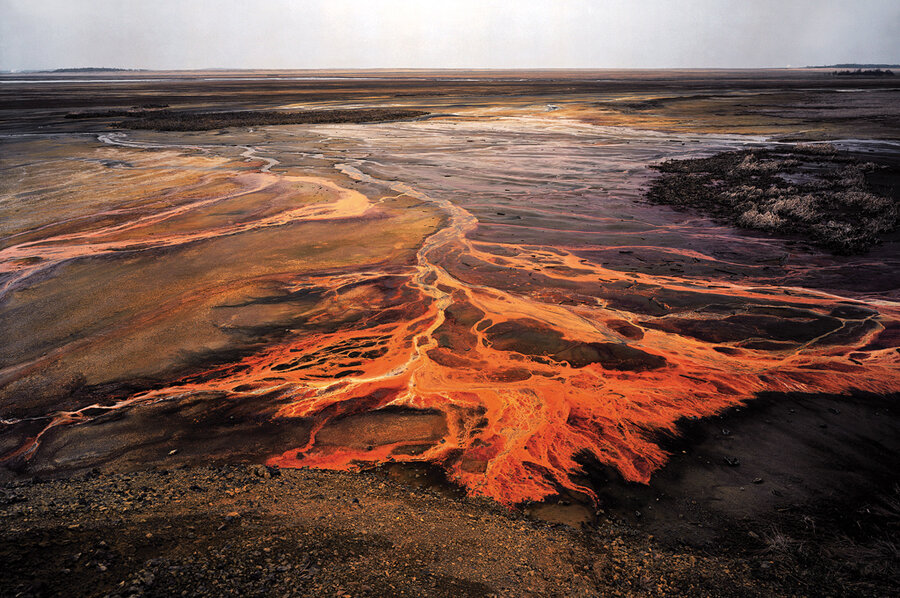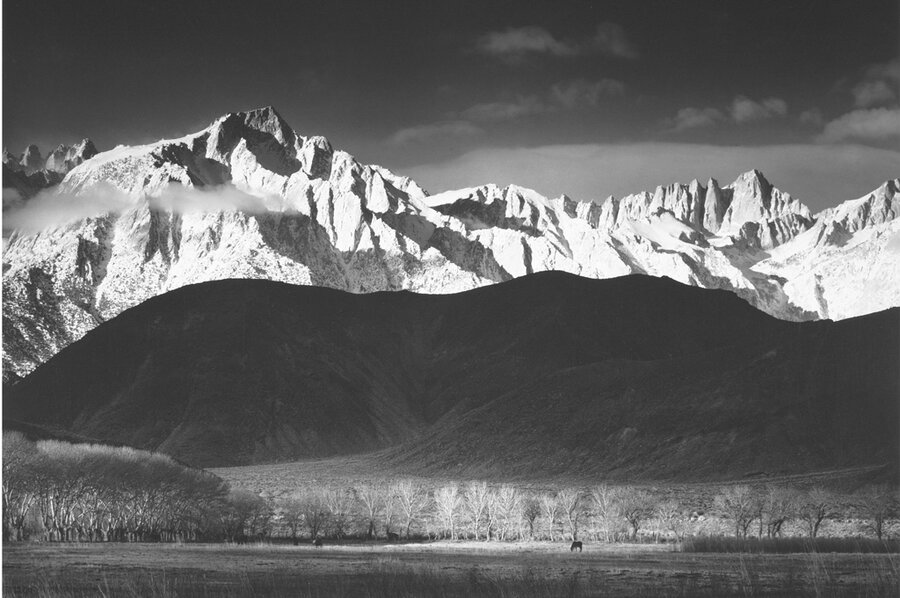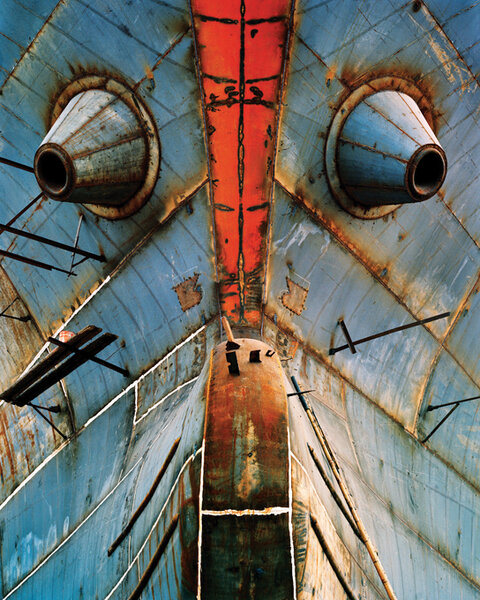Edward Burtynsky and Ansel Adams: A pairing of devastation and beauty
Loading...
| Shelburne, Vt.
Last month, Stephan Jost felt jittery, not because he was curating the Shelburne Museum's inaugural photography exhibit, but because the exhibit presents more than 60 prints by 20th-century American photographer Ansel Adams and contemporary Canadian photographer Edward Burtynsky – artists whose respective works, on the surface, seem diametrically opposed.
"Ansel Adams and Edward Burtynsky: Constructed Landscapes," which runs through Oct. 24 at the Vermont museum, features four rooms of Adams's signature black-and-white wilderness photographs and three rooms of Burtynsky's color photographs of rock quarries, coal heaps, and rusty ships in North America and Asia.
"This pairing makes both of them look better," says Mr. Jost. "It makes Adams more interesting and relevant, and it makes Burtynsky look aesthetically stronger, because he can stand up to Adams's work."
When Adams died in 1984, he left a formidable legacy: The San Francisco native's photographs of the American West promoted photography as a fine-art medium and created iconic visuals for the American conservation movement. In a 2001 introduction to a major Adams retrospective, the San Francisco Museum of Modern Art called him "one of the century's great modern artists."
Adams's photos are small – typically the size of a legal pad – but he captures landscapes and nature scenes in a way that simultaneously conjures aesthetic themes of 19th-century Romanticism and 20th-century Modernism.
In "Winter Sunrise, Sierra Nevada from Lone Pine, California, 1944," for example, snowcapped peaks recall writings by 19th-century naturalist John Muir, a cofounder of the Sierra Club. Meanwhile, a dramatic contrast between the peaks and an ominous black foreground reflects Adams's aesthetic affinities with such fellow Modernists as the photographer Paul Strand and the painter Georgia O'Keeffe.
Burtynsky's self-styled "residual landscapes" impress for different reasons. The washing-machine-sized prints document scenes from contemporary factories, shipyards, and oil fields, forcing us to ponder connections and tensions between material consumption, industry, and ecology. Viewers not familiar with Burtynsky's photos or "Manufactured Landscapes," the award-winning 2006 documentary film that chronicles his globe-trotting, may be equally saddened and cheered by the devastation and beauty he captures in such desolate environments.
"Is that coal?" one incredulous visitor asked on a recent afternoon as she pondered Burtynsky's "Tanggu Port #1, 2005," a bird's-eye view of a sprawling coal port in Tianjin, China, where heaps of coal vaguely resemble forested hills.
Burtynsky's most provocative photograph in the exhibit may be "Tailings #30, Sudbury, Ontario, 1996," a pastoral landscape tainted by bright-orange nickel residue. Although Burtynsky photographed the industrial effluent in his native Canada, it brings to mind the Exxon Valdez and Deepwater Horizon oil spills – and their impact on marine ecosystems.
"Our dependence on nature to provide the materials for our consumption, and our concern for the health of our planet sets us into an uneasy contradiction," Burtynsky writes in his gallery statement. "For me these images function as reflecting pools of our times."
Jost predicts that viewers will "come for the Adams [photographs] and leave talking about Burtynsky." Burtynsky's images, he says, are counterpoints to Adams's pristine landscapes, which do not visually address globalization.
By juxtaposing Adams and Burtynsky, Jost attempts to present a simplified "continuum" between nature and industry. "I'm not sure where people should live on that continuum," the curator says. "But I'm trying to provoke a conversation."
In reality, landscape photographers have always oscillated along the nature-industry continuum. Jost explains that early American landscape photographers were documenting both nature and human impacts on nature as early as the mid-19th century, when railroad companies and the US government paid them to record track construction and undeveloped land.
Ansel Adams and Edward Burtynsky are part of that tradition. While Adams served on the board of the Sierra Club and loved to photograph the Sierra Nevada, he also accepted commissions from U.S. Potash, the Pacific Gas and Electric Company, and the Kennecott Copper Corporation;. Today Burtynsky photographs industrial activity with permission from companies, and, according to Jost, his work is praised by both environmentalists and CEOs.
Unfortunately, "Constructed Landscapes" doesn't include any of the industrial photographs that Adams produced – images that may have established a stronger visual link between the featured photographers. Jost says he considered including Adams's industrial photos, but worried that they might have "raised another group of questions that I wasn't trying to raise" about the photographer's legacy.
Still, Adams's industrial side pokes through in "Cemetery Statue and Oil Derricks, Long Beach, California," a 1939 photograph in which oil derricks form a faint backdrop for a stark white statue. Jost claims that the print, a clear departure from Adams's sublime landscapes, "quietly undermines the polarity of the exhibit."
Another surprise: When Adams photographed "Dunes, Oceano, California, from Portfolio IV, 1963," one of his clients, the Pacific Gas and Electric Company, was proposing to build a nuclear power plant in the Oceano area – over fierce opposition from factions of the Sierra Club.
After negotiating with the club, the company eventually agreed to build the plant in a different, but nearby, location. Adams, a longtime Sierra Club board member, supported the compromise, but other members claimed their organization was selling out to corporate interests. Adams urged compromise, suggesting that nuclear was a better alternative than fossil fuels.
In a 1969 letter to the editor of a Sierra Club newsletter, Adams sounds a bit Burtynskyan: "I wish all members of the Sierra Club could realize they live in a different world than that of John Muir!" he wrote, defending his decision to support the nuclear proposal. "The problems are immense. An adult attitude towards all the forces of society is imperative."
The letter suggests that Adams, like Burtynsky, understood the need to balance an appreciation for nature with an awareness of modern realities. Indeed, says Jost, while Adams has been canonized as a nature photographer, "He's much broader and [more] interesting than people realize."
If this exhibit hints at a broader Adams, it also celebrates Burtynsky's nuanced ecological sensibility. In a back room of the gallery, four Burtynsky photographs document the "shipbreaking" of a tanker in Bangladesh. The color prints could be stock footage for a shipping company. But upon closer inspection, the series shows a ship's transition from disrepair to reuse – a kind of mechanical life cycle.
Jost says the photographs express "seasonality," a word that normally describes spring showers and fall foliage. Perhaps that is Burtynsky's point: At a moment when the largest oil spill in American history looms off Louisiana's coastline, his photographs remind us that natural forces inform even noxious industrial processes.
Because we have to live on this planet, Burtynsky seems to say, we should appreciate landscapes no matter how tarnished they appear.








